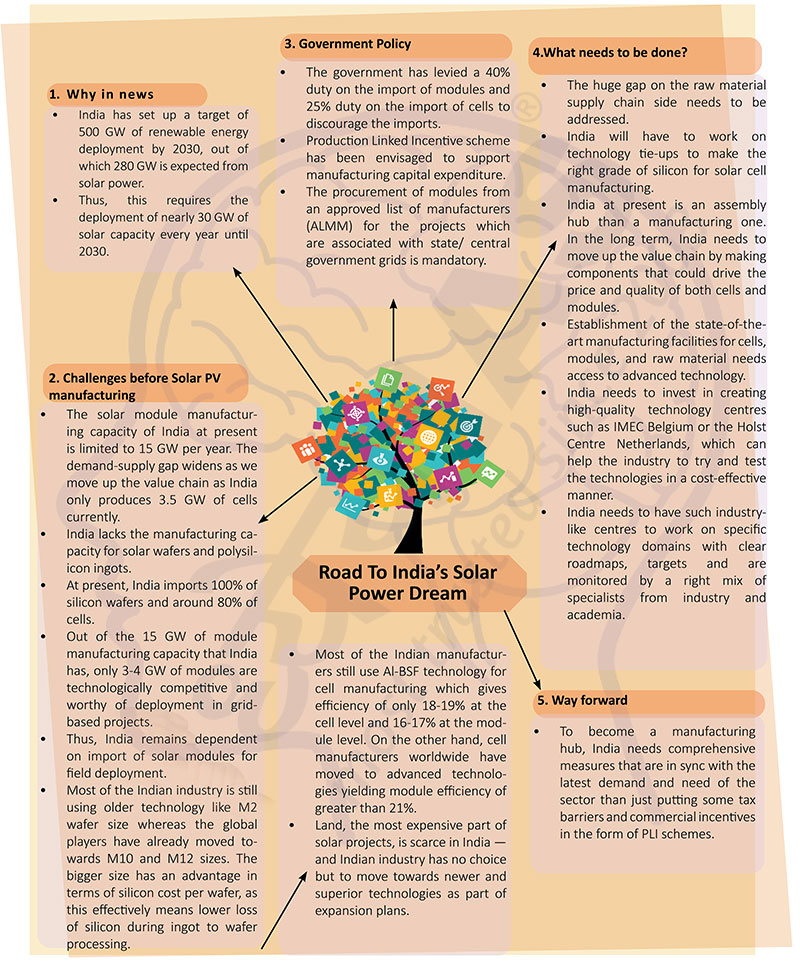Brain-booster /
06 Sep 2022
Brain Booster for UPSC & State PCS Examination (Topic: Road to India’s Solar Power Dream)

Why in news?
- India has set up a target of 500 GW of renewable energy deployment by
2030, out of which 280 GW is expected from solar power.
- Thus, this requires the deployment of nearly 30 GW of solar capacity
every year until 2030.
Challenges before Solar PV manufacturing
- The solar module manufacturing capacity of India at present is limited
to 15 GW per year. The demand-supply gap widens as we move up the value
chain as India only produces 3.5 GW of cells currently.
- India lacks the manufacturing capacity for solar wafers and polysilicon
ingots.
- At present, India imports 100% of silicon wafers and around 80% of
cells.
- Out of the 15 GW of module manufacturing capacity that India has, only
3-4 GW of modules are technologically competitive and worthy of deployment
in gridbased projects.
- Thus, India remains dependent on import of solar modules for field
deployment.
- Most of the Indian industry is still using older technology like M2
wafer size whereas the global players have already moved towards M10 and M12
sizes. The bigger size has an advantage in terms of silicon cost per wafer,
as this effectively means lower loss of silicon during ingot to wafer
processing.
- Most of the Indian manufacturers still use Al-BSF technology for cell
manufacturing which gives efficiency of only 18-19% at the cell level and
16-17% at the module level. On the other hand, cell manufacturers worldwide
have moved to advanced technologies yielding module efficiency of greater
than 21%.
- Land, the most expensive part of solar projects, is scarce in India —
and Indian industry has no choice but to move towards newer and superior
technologies as part of expansion plans.
Government Policy
- The government has levied a 40% duty on the import of modules and 25%
duty on the import of cells to discourage the imports.
- Production Linked Incentive scheme has been envisaged to support
manufacturing capital expenditure.
- The procurement of modules from an approved list of manufacturers (ALMM)
for the projects which are associated with state/ central government grids
is mandatory.
What needs to be done?
- The huge gap on the raw material supply chain side needs to be
addressed.
- India will have to work on technology tie-ups to make the right grade of
silicon for solar cell manufacturing.
- India at present is an assembly hub than a manufacturing one. In the
long term, India needs to move up the value chain by making components that
could drive the price and quality of both cells and modules.
- Establishment of the state-of-theart manufacturing facilities for cells,
modules, and raw material needs access to advanced technology.
- India needs to invest in creating high-quality technology centres such
as IMEC Belgium or the Holst Centre Netherlands, which can help the industry
to try and test the technologies in a cost-effective manner.
- India needs to have such industrylike centres to work on specific
technology domains with clear roadmaps, targets and are monitored by a right
mix of specialists from industry and academia.
Way forward
- To become a manufacturing hub, India needs comprehensive measures that
are in sync with the latest demand and need of the sector than just putting
some tax barriers and commercial incentives in the form of PLI schemes.








